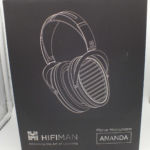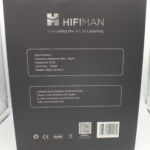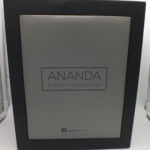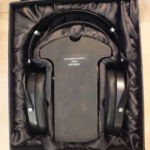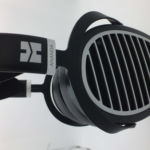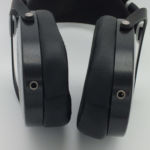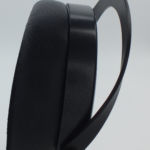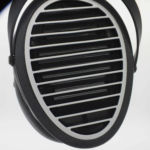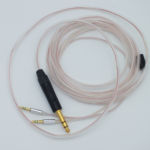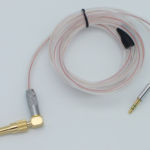Hifiman Ananda
disclaimer: I received the Ananda as part of the Head-fi tour and would like to extend a thanks to Hifiman for giving me the opportunity to try them out. I received no guidance or incentives to write this, and upon completion the Ananda (sadly) went on to the next reviewer.
Unboxing / Accessories:
Having recently reviewed the He6se, I immediately recognized the packaging as both share the nice leather(ish?) display box. The outside of the package sports the same color scheme as the headphones themselves in black and gray although the proportions are reversed with gray being the main color of the lid and black the sides.
Inside the box is satin covered foam with a precise cutout for the headphone itself and a cutout in the center for cables and accessories. A foam plate hides the center compartment and insures cables do scratch the cups during transit. I use the term transit intentionally here as it is by no means a travel case and for a portable headphone, this is something Hifiman should consider adding to the mix. Rounding off the kit is a 3.5mm cable with 6.35mm adapter, and the user manual which reads as much like ad copy as instructions. It contains the history and tech used in the Ananda as well as some rudimentary instructions. Honestly for a headphone designed as a portable, I have to question as to whether the choices made regarding the cable couldn’t be considerably improved upon. More on that later.
Build/Fit:
The headband is the new style similar to the He6se I have tested recently. The upside of that change is it is considerably more durable than the earlier versions. the downside is it loses the rotation of the cup on the vertical axis so may cause fit problems for some. I found the cup shape allowed a better fit than the same headband afforded with the He6se while a friend found the reverse to be true. Clamping force is relatively low and combined with the light weight of the Ananda makes them comfortable for extended wear. My neck is much less fatigued after an extended listening session than it was with the LCD-2X or He6Se. Before dropping the cash on the Ananda I’d highly recommend finding a loaner program where you can conduct an extended audition to be sure the fit is good.
Moving to the cups, they are the extended type similar in design to the edition X, He1000, Arya, and Jade making them the least expensive Hifiman with this style cup and gimbal system. Cups are flat black with Silver/polished steel louvered grills that reduce driver reflections and still protect the driver from impacts. The 3.5mm mono connectors are angled slightly forward and give an easy way to upgrade cables if so desired without the expense of proprietary connectors. Pads are soft leather and sloped to help with fit since there is no vertical rotation of the cups. For many this will be enough to offset that lack, for a few it won’t as previously mentioned. Pads snap into place with a series of small clips that attach to a metal ring inside the shell. Removing the pads exposes a really fantastically artistic driver. To me the Ananda design is as much art as science and Hifiman succeeded at making a really pretty headphone.
Internals:
Like most of Hifiman’s over-ear models, the Ananda utilizes a Planar magnetic driver, unlike others, the driver in the Ananda is a new design aimed squarely at making planar drivers easier to drive and thus usable with a broader selection of devices. The diaphragm is called the Neo SuperNano Diaphragm and is between 1 and 2μm thick. Hifiman’s claim is that this is 80% reduction in thickness and weight when compared to the standard planar driver, and both the thickness and weight (or lack thereof in this case) contribute to how difficult a headphone is to drive. In the case of the Ananda, the results are a nominal impedance of 25Ω with a sensitivity of 103dB/mW. I found the ananda easy to drive using my portable DAPs, but it certainly benefits from better sources and will gladly soak up more power if it is made available. To hear a full size planar that doesn’t sound extremely anemic when driven from a portable is a new experience for me though, so I do think Hifiman by in large achieved their stated goal. That having been said, the Ananda still needs more power than most cellphones or tablets can muster and will lose some range when under-powered. The only planar I have heard that performed well with less power is the Sine, and realistically the Sine is not a competitor for the Ananda in any other measure.
Cables:
The cables that shipped with the Ananda are quite similar in construction to that which shipped with the He6se. That is both a good thing, and a not so good one. Good stuff first, very pliable, very well made, low microphonics, and very solid connectors. The main difference in the cable between the He6se version and the Ananda version is the source terminations which reflect (kindof) the idea that the Ananda was designed for portable use. The He6se came with either 6.35 or XLR connectors while the Ananda comes with 3.5mm with a 6.35 adapter and a 6.35mm terminated version.
On to the not so good, the cable is obviously a compromise between desktop and portable applications and to me, kind of looks like Hifiman phoned it in and said just use what we already have. For as much work as went into making the headphone appropriate to portable use, the cable simply doesn’t fit. With most all high-end portable devices offering either 2.5 or 4.4mm balanced connections, why would you not supply a 2.5mm terminated cable with an adapter to connect either a 4.4mm balanced or 3.5mm single ended device? If you really wanted to offer a 6.35mm connector, I’m sure a 2.5mm to 6.35mm version could be fashioned as well. I also found the length of the cable to be considerably longer than desirable for portable use. Overall, if you are going to travel with the Ananda, plan on buying an aftermarket cable.
Sound:
Since the Ananda is billed as a portable, I ran it using both portable gear (xduoo xt10ii/iFi xDSD and Dethonray DTR1/Oriolus BA300s) as well as desktop gear (Schiit Bifrost MB/Valhalla 2 and Burson Swing/Fun (upgraded w SparkOS Op-amps)). As mentioned previously, the Ananda will operate with lower power, but it definitely benefits from more power qualitatively, if it can’t quantitatively to the degree that some other models (He6se) can. My notes regarding sound quality are combined from all devices and where exceptions came up, I noted the device pairings.
Bass:
Sub-bass on the Ananda can only be described as minimal. Roll-off begins high enough up that anything below 150Hz is well behind the rest of the signature. Those looking for more low end, will be better served by other models in the Hifiman lineup. Mid-bass is much better represented and realistically from about 200Hz up, linearity is very good. To my ear, mid-bass is neutral or just a hair less, but mid-bass detail and texture are extremely good. While I would prefer a bit more bass, the fact that what the Ananda presents is as clean and well defined as it is, makes what is missing almost ignorable. Transition from the bass into the lower mids is very smooth and clean and where mid-bass bleed usually contributes a bit of warmth to the signature, here the tuning provides it as no perceptible bleed was present.
Mids:
I was told the Ananda was a replacement in the line for the aging He560 (which I own and enjoy) but the mids separate the Ananda from being an He560 replacement in my view. The He560 has great linearity through the mids, which is quite simply not something the Ananda can claim. While the lower mids are nearly linear with the mid-bass, the upper-mids and lower-treble are both lifted above the rest of the signature. I use the word lifted instead of pushed as it is quite tastefully done and gives vocals a bit more life, but it does take the Ananda out of the running as the best truly neutral model available. Mid quality is nothing short of fantastic with detail level and texture again being excellent. If anything vocals come off just slightly thicker and warmer than absolute neutral.
Treble:
Lower treble transitions from the upper mids smoothly and doesn’t have any notable spikes or dips. Treble is well detailed and has good texture. I did find timbre to be a bit bright at times as the Ananda seems to have an elevation in the 7kHz range that extends through somewhere between 9 and 10kHz. The upper end is tough to pin down as it seems to vary with source material. In this case bright should not be thought of as synonymous with harsh though. The Ananda maintains good control throughout the top end and while it has a bit of extra energy, it is not harsh and somehow actually manages to sound a bit relaxed and gentle. Again, the Ananda takes on the character of the recording. Poor recordings come off as thin, tinny, and metallic. Better recordings sound much more lifelike and lose that edge. Well recorded strings are a pleasure on the Ananda as it gets their timbre closer to spot on than most.
Soundstage / Imaging:
I expected good things in this department as the big planars usually deliver and the Ananda certainly does. Stage is large in all dimensions with width being slightly larger than depth. Perhaps most impressive is the sense of height conveyed by the Ananda. Imaging is equally good as instrument seperation is quite spacious and detail and clarity makes seating the orchestra very straight forward. Nothing is next to each other that should be behind, and layering is good enough that instruments in front/back arrangement are still both clearly audible with no overlap or loss. Songs like The Who – Baba O’riley and The Cars – Moving in Stereo have various voices and instruments moving effortlessly around the stage and the ear is able to follow their movement from one point to the next, not just hear the endpoints. In this measure, the Ananda is just shy of the greats like the HD800. I think the term Holographic gets used too much in defining audio soundstage and imaging but the Ananda deserves the moniker. If you have ever wondered what people meant by Holographic, get an Ananda and Who’s Next (Vinyl or Flac) and take a listen.
Comparisons:
Campfire Cascade
At first glance these two have little in common, closed dynamic vs open planar, a $400 price difference, and design elements that both represent their makers. What they do have in common is they are the best efforts of two companies to make a headphone for on-the-go use. The funny thing to me is, as different as they look, they weigh nearly exactly the same thing. Consider that for a second, the Cascade looks built for military use, while the Ananda appears much more delicate and finessed, but both weigh within 10 grams of each other. Clamping force is much higher on the Cascade so those with larger heads may prefer the Ananda for that alone. Conversely, smaller heads may find the clamping force of the Cascade makes them more usable if on the move. I compared sound with filter 2 and the cloth pads on the Cascade which is my favorite tuning.
Even with the cloth pads, the Cascade has considerably more bass quantity (particularly sub-bass) than the Ananda. Both are tight, but the Ananda is a bit faster and shows off a bit more detail in the mid-bass as a result. Both are detail monsters in the mids and for me it is hard to pick a winner here as I like the timbre of acoustic guitar a bit better on the Ananda and its electric counterpart a bit better on the cascade. Highs are cleaner on the Ananda, but again both are polite tunings that manage to deliver enough treble to have good air and sparkle without getting strident or piercing. Turns out the two may have something in common after all.
Mr Speakers Aeon Flow Open
This seems like it should be an apples to apples comparison as both are from premier makes, both are open planars, and both are aimed at the portable space. There the similarities end though. The Aeon is the lighter of the two by almost 1/4 the total weight. When combined with a headband that offers more adjustment, the Aeon feels a little better on the head than the Ananda.
The Aeon Flow was notably harder to drive than the Ananda and much more source sensitive. Big planars are rarely a good match with tubes, but the Aeon seems particularly poor where as the Ananda actually paired well with the Valhalla2/Bifrost MB combination. The Aeon can sound a bit clouded with pairings it doesn’t care for and is probably best paired to neutral to a bit dry/cold solid state gear. The Ananda on the other hand doesn’t seem to care what feeds it and while it scales with better gear, it showed the ability to handle sources as diverse as the Cayin N3, Burson Fun, Oriolus BA300s, Valhalla2, SSMH, and Millett Nu-tube Hybrid.
The Aeon sounds a bit warmer and thinner in comparison to the Ananda and the emphasis is in different regions. I already mentioned a slight upper-mid push and a 7kHz elevation on the Ananda, by comparison the Aeon has a mid-bass lift and then recesses the mids with a push back forward at the upper-mid/lower treble junction. Transitions are a bit smoother on the Ananda, the mid/treble transition is particularly so as the Ananda sort of effortlessly flows from one to the next while the Aeon Flow has some jagged edges.
To my ear, the Aeon Flow comes across as the more musical of the two with a bit more thickness to the sound, but it loses to the Ananda on all the technicals. The Ananda is the more accurate of the pairing with bigger stage, better imaging and layering, more detail, and a more neutral overall presentation. Choosing between these two comes down to critical listening vs listening for pleasure for me.
Audeze LCD-2
Admittedly, the LCD-X is probably the better comparison spec-wise as the LCD-2 is much higher impedance and harder to drive than the Ananda, but I did not have the LCD-X on hand to compare. The LCD-2 is considerably heavier than the Ananda at roughly 500 grams vs the Ananda’s 400. The Ananda feels lighter than the actual weight difference as well as the headband does a better job of distributing weight. I’m not a fan of the pads on the LCD-2 either and have long since replaced mine with Dekoni pads, but still find the pads on the Ananda to be more comfortable. Both have angled connectors although I like the LCD version a bit better with its Mini-XLR and steeper angle than the 3.5mm of the Ananda. Both are solid, I just prefer the look of the LCD connector better.
Sound is very different between the two. The LCD-2 has a boosted low end, while the Ananda does not. Bass lovers will gravitate to the LCD series for that alone. Bass clarity is roughly equal on both with a slight advantage to the Ananda in texture to my ear. Mids are similar between the two if a little thicker on the LCD and slightly better clarity on the Ananda. Highs are again similar as both models are slightly rolled off and smoothed over. Detail levels are similar in the upper ranges, but again timbre and texture as improved on the Ananda as the attack on percussion is a bit sharp and snappy on the LCD-2.
Sennheiser HD800
Here we have another one of those comparisons that at first glance doesn’t look to be well thought out. I’ll admit I did this one based on the soundstage of the two being similar (a huge complement to the Ananda in and of itself).
Obvious things first, these two are not designed for the same market. The HD800 is a 300Ω model designed for seated use while tethered to a potent amp and is really somewhat picky about what it gets paired with. The Ananda is 25Ω model that can be driven by a smartphone in a pinch.
Now for the not so obvious, The HD800 with its plastic construction is nearly 100 grams lighter than the Ananda and to me is an easier fit and more universal in fit. Those same friends I mentioned earlier that had trouble getting the Ananda adjusted had no issues with the HD800. Clamping force is slightly higher on the HD800 but not so much as to be uncomfortable for long wear. To me, the HD800 is the benchmark for soundstage and imaging, it quite simply has better imaging and stage than anything else at anywhere near its price point and easily defends that crown against a lot of things priced much higher. The downside is the HD800 has the now famous 6k spike that the Anax mod calms a bit but does not completely remove. Here the Ananda scores points for being a model with a more polite and even treble with almost as good a stage and imaging as the HD800. In fairness, detail level is better on the HD800 but those who like the stage on the 800 but not the treble will do well to give the Ananda a listen.
Thoughts / Conclusion:
The Ananda is a very comfortable headphone for me, but some may have some fit issues with the lack of swivel on the vertical axis. The cable is an also ran and if really targeted to a mobile market, Hifiman would be better served to package it with a 2.5 or 4.4 mm balanced cable. This effectively increases the asking price by $200 at minimum as the cable will likely be replaced by the target audience. Sound wise, the Ananda is slightly below neutral in the low end and then has a small emphasis on mid-bass and lower mids, near linear mids through treble and another push in the 7k-10k range. Both are enough to be notable departures from neutral, but both add musicality to the sound. Detail level is quite good as are attack and decay which is to be expected from a big planar. Soundstage and imaging are fantastic and only slightly behind the vaunted HD800 in that respect. The Ananda is the easiest of any Hifiman’s planars to drive and close to the easiest of all planars (The LCD-X may claim that title). The other nice thing is the Ananda is fairly forgiving of source and worked equally well from the xCAN and the Valhalla 2. Most boutique headphones seem to be fairly picky about pairings so it is nice to see one that performs well with a wide range of options. Overall, the Ananda is one heck of a headphone for the asking price and an easy recommendation if you are in the market.
-
Bass - 7.5/107.5/10
-
Mids - 8/108/10
-
Treble - 8/108/10
-
Soundstage - 9/109/10
-
Imaging - 9/109/10
Summary
Pros: Great soundstage and imaging, near neutral performance with a couple elevations for increased musicality.
Cons: Cable not the same quality as the headphones, no travel case.


